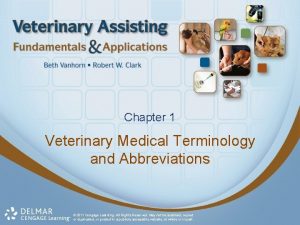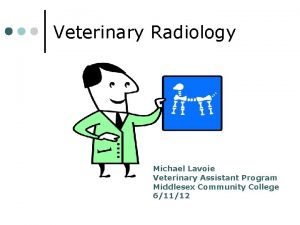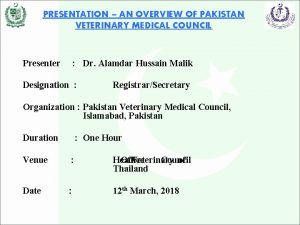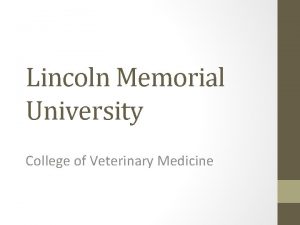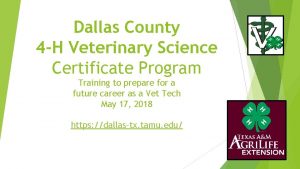CH 1 INTRO TO VETERINARY TERMINOLOGY Where did

















- Slides: 17

CH 1. – INTRO TO VETERINARY TERMINOLOGY


Where did they get these words from? ? ? • 75% are based on _______ origin • Veterinary medical terms are based on human medical terms. • Greeks were the founders of modern medicine • Latin is the universal source of medical language

Ok, I don’t know either of those languages, so how am I supposed to learn these terms? There are many ways to learn a large amount of veterinary terms: • Breakdown words into their parts to simplify difficult vocabulary. Find the parts that you know/recognize. – prefix, suffix, root word (aka: elementary reading) • Learn basic anatomy and physiology of each body system (which you will be doing in this class and A & P)

• Relate the words and their parts to each body system • Many of the same terms are used throughout the different aspects/branches of veterinary medicine (Large animal, small animal, lab animal, exotics, research, etc. . ) • Be creative! Use pictures, diagrams, charts, and flashcards to help you with the many, many words. • Use textbooks and dictionaries (the answers are in them, you just have to look them up) • Do the end of chapter exercises and questions (the test before the test). THE ANSWERS ARE IN YOUR BOOK.

REVIEW • PREFIX: ______ of a word • SUFFIX: ______ of a word – RULE – prefixes and suffixes can never be alone without a root EXAMPLE: The intra- is a preto the –oma of the -itis.

• ____: foundation or basic meaning of a word that may appear with a prefix or suffix • _______: a root with an added vowel that combines the root with a suffix or another root to make pronunciation easier • ______: a word that contains more than one root and each retains their meanings

TIME FOR SOME EXAMPLES: • ANTISEPSIS – – PREFIX: anti- = ______ – ROOT: -sepsis = ______ • RHINITIS – – ROOT: rhin- = _______ – SUFFIX: -itis = _______

EXAMPLES, CONT’D • ARTERIOSCLEROSIS – – – ROOT: arteri- = ______ COMBINING VOWEL: o ROOT: scelr- = _______ SUFFIX: -osis= _______ – NOTE: this is an example of compounds

Now you know what the word means, but can you pronounce it? • “ch” can sound like “____” – EXAMPLE: chronic (pronounced kronic) • “ps” can sound like “____” – EXAMPLE psychologist (pronounced (sycologist) • “pn” can sound like “____” – EXAMPLE: pneumonia (pronounced newmonia)

PRONOUNCIATION CONT’D • “c” can sound like “s” and “g” can sound like “j” if placed before the letters “___”, and “___” – EXAMPLES: cellar (pronounced sellar), cypress (pronounced sypress) general (pronounced jeneral), gel (pronounced jel) • “ae” and “oe” are pronounced ee – EXAMPLE: algae is pronounced algee

PRONUNCIATION CONT’D • “i” at the end of the word is pronounced “eye” and makes the word ____. – EXAMPLE: Carpus is the wrist. A dog has two carpi. • es at the end of a word can sound like “_____” – EXAMPLE: Nares (the nostrils) are pronounced nare – eez, phalanges (the fingers) are pronounced falange - eez

HOW TO MAKE A WORD INTO THE PLURAL FORM • Sometimes you may just add an “s” or “es”, however “ae”, “ia”, “i”, and “ata” are also ending that can make a word into its plural version – EXAMPLES: lacuna becomes lacunae, mitochondrion becomes mitochondria, glomerulus becomes glomeruli, and stoma becomes stomata

S-P-E-L-L-I-N-G Counts! • YOU MUST SPELL CORRECTLY! – Imagine if your personal medical chart read: “This payshent has a feever and a headayke. ” • This does not mean that you should spell phonetically (how the word is pronounced).

S-P-E-L-L-I-N-G • Some medical terms sound exactly alike, but are spelled differently and have different meanings. – EXAMPLE: – _______ = a part of the bones of the pelvis – _______ = a section of the intestinal tract – You cannot write in a chart that a patient has a fractured ileum, or that the ilium has an obstruction. It does not make sense and misinterpretation could lead to a misdiagnosis.

TO MAKE IT EASY ON YOURSELF… • Organize the material that you learn each day and break it down into sections. For instance, prefixes vs. suffixes. DO NOT WAIT UNTIL THE NIGHT BEFORE THE EXAM/QUIZ TO STUDY! • Find examples of words that you already know to make it easier to remember meanings and pronunciation, even if your examples are not medical terms. – For instance, you knew the meanings of the words antibacterial, preschool, hyperactive, cardiologist, telescope, and biology before starting this class. Use what you already know!!

• DO THE REVIEWS. They are a way of testing yourself before the test. • Write the words as you learn (make flash cards). Saying them as you write them will help you to remember the meaning, pronunciation, and spelling. • Quiz each other. This allows both people to practice saying words and reviewing definitions (and you will make a friend ).
 Word drill suffixes 1
Word drill suffixes 1 Veterinarian suffix
Veterinarian suffix Veterinary pronounciation
Veterinary pronounciation Introduction to veterinary terminology
Introduction to veterinary terminology Veterinary waste disposal legislation
Veterinary waste disposal legislation Flattened diaphragm
Flattened diaphragm Father of veterinary parasitology
Father of veterinary parasitology Veterinary medicines directorate
Veterinary medicines directorate Bcse sample questions
Bcse sample questions Veterinary nurse conduct and discipline rules 2014
Veterinary nurse conduct and discipline rules 2014 Pros and cons of being a veterinary technician
Pros and cons of being a veterinary technician Veterinary council of pakistan
Veterinary council of pakistan Uclan vet school
Uclan vet school Ministry of agriculture veterinary services
Ministry of agriculture veterinary services Lincoln memorial university college of veterinary medicine
Lincoln memorial university college of veterinary medicine Chemical hazards in a veterinary clinic
Chemical hazards in a veterinary clinic Veterinary jeopardy
Veterinary jeopardy Veterinary radiology dallas county
Veterinary radiology dallas county

